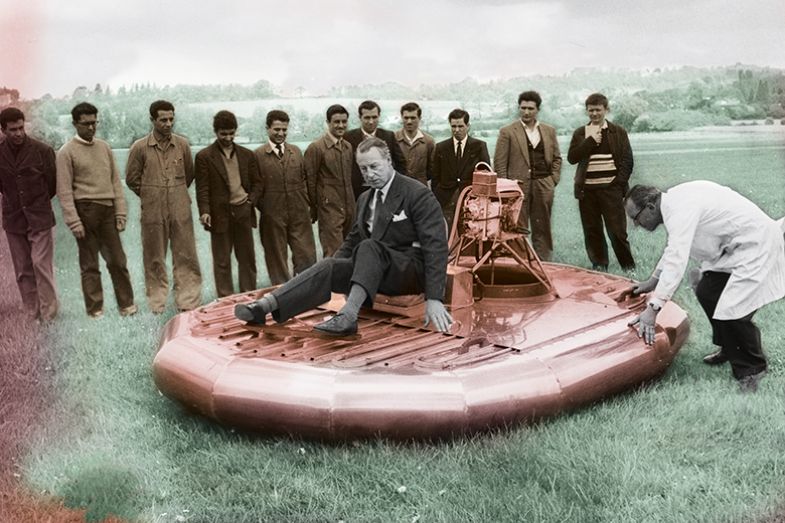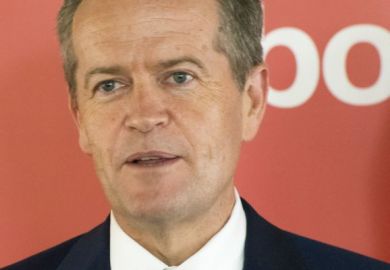When Dublin-born chemist David Lloyd became Australia’s youngest ever university boss in 2013, he resisted marking his arrival with some bold new statement of strategic direction, quietly developed in the confines of chancellery and polished to a glossy sheen by the marketing unit.
Instead, Lloyd unleashed generational change befitting a 38-year-old vice-chancellor. He enlisted not only the university community but also its global extended family to help the University of South Australia hone its mission. “Unijam” made use of IBM technology to inject thousands of people into round-the-clock online conversations structured around themes, with registered participants logging in whenever they liked to gatecrash existing discussions or start new ones. The university says nearly 8,000 people from 56 countries registered for the 38-hour event, posting almost 18,000 comments across more than 1,300 conversation “threads”, overseen by IBM-trained umpires.
Special guests recruited to lead discussions included the South Australian premier at the time Jay Weatherill, former Australian prime minister Bob Hawke, former UniSA vice-chancellor Denise Bradley and Nasa administrator Charles Bolden. Lloyd says the event reminded him of a charity telethon, the highlight of which was Bolden’s segment about the importance of organisational culture.
“Charlie is talking in his kitchen in Washington DC,” Lloyd recalls. “A graduate student chimes in to ask a question, and the conversation builds. Suggestions float up through the jam technology. At this stage, it’s a social network. People start to like the ideas.”
For example, a professor proposed cultural awareness training for all students. “Lots of people would like that idea. Then there would be a conversation about what that means in the context of getting a strategic plan. How would you operationalise this? What’s the benefit of doing it? How will we know it’s successful?...It’s risky because you’re asking people what they want. And if they don’t get what they want, they’re not going to be happy.”
Lloyd’s approach, which culminated in his 2013-2018 strategic plan, Crossing the Horizon, was perhaps the antithesis of the managerialism increasingly decried in endless academic complaints about agendas imposed from the top – and often outlined in strategic plans that contain “a lot of fairly empty words”, according to Melbourne economist Jamie Doughney.
Doughney, formerly a staff-elected member of the governing council of Victoria University (VU), says that the primary driver of most strategic plans is the leadership’s craving for status. And the plans’ defining feature – like that of the institutions whose destinies they supposedly chart – is their “sameness” – both in terms of their common “focus on status” and their “hideous propensity to [employ] the most execrable prose known to humanity”.
“We’ve had years of strategic planning, which becomes a bit of an industry in itself, and what is there to show for it? Essentially, what we’ve got are universities that are pretty much the same,” Doughney says.
Despite all this, the documents sometimes herald meaningful change. Doughney credits VU’s strategic plan for its adoption of Sweden’s “block teaching” system, whereby students study one module at a time rather than juggling several. This innovation – arguably the only real departure from the norm by an Australian university, operationally speaking, in the past decade – had its genesis in the use of strategic planning “to transform the way the university does its teaching in light of the nature of its students and their needs”, Doughney says.
“You’ve got this big old rusty, leaking ship that you want to turn around,” he says. “It’s very difficult because the engine room is being asked from the bridge to pump up the revs, but the boiler room is having its morning tea and not putting fuel in the engine. You’ve got most of the officers working out how their little bit of the ship can get the best advantage, and not actually helping in the process. You’ve got all that happening. When a strategic direction has been put down, it helps to some degree in keeping things clear and holding the disparate parts of this rusty old vessel to account.”
Lloyd says that far from making UniSA a carbon copy of neighbouring institutions, its strategic plan – and the crowdsourced input – helped entrench its point of distinction as “Australia’s university of enterprise”.
“Without a strategy, you don’t get that end point,” he says. “If we hadn’t done it, we would have been like every other university. We’d be aspiring to have great research, but the research would be in pockets where you’ve got individual superstars, not clusters [from which] you can build in scale and focus.”
Melbourne tertiary education consultant Justin Bokor notes that most universities outside the large research-intensives have to decide where to concentrate their research efforts – and strategic plans help them to do that. He cites James Cook University’s focus on tropical environments and communities, the University of Tasmania’s emphasis on maritime science, the Australian Catholic University’s prioritisation of health and education and the highlighting by the University of Technology Sydney (UTS) of innovation. “Most universities have quite a distinct focus in their research, and [strategic plans] help articulate it,” Bokor says.
Other universities base their strategy more around their reputational aspirations. One notable example is Cardiff University, whose 2012 strategic plan, The Way Forward, set a public goal of being ranked in the top 10 in the UK’s 2014 research excellence framework by grade point average. In the event, it was ranked sixth: up from joint 22nd in the preceding research assessment exercise six years earlier.
It took flak in some quarters for its tactic of drastically reducing the number of people whose work it submitted in order to maximise its GPA; the 62 per cent of eligible staff it submitted was the lowest in the Russell Group of large research intensives by some distance. However, in a bullish letter to Times Higher Education, vice-chancellor Colin Riordan defended the approach as “transparent, strategic and highly successful”.

British-born barrister Stephen Parker says that for all the cynicism about strategic plans, a university without one would incur the displeasure of its accrediting agency and governing body – not to mention its own employees.
“To deny staff such an easy topic of derision is cruel indeed,” says Parker, who was vice-chancellor of the University of Canberra for nine years and is now lead education consultant with professional services firm KPMG Australia.
He says strategic plans are also the obvious place to entrench universities’ statements of values. “Again, these can be derided as bland, but what would the alternative look like?”
Gavin Moodie, an adjunct professor with the Ontario Institute for Studies in Education at the University of Toronto, says some strategic planning processes are designed to elicit outsiders’ perspectives. But most are internally focused, seeking to mobilise academics to adopt new directions.
“The internally directed strategic plans tend to be very dull reading for outsiders, and often convey little to external readers,” Moodie says. “But seemingly anodyne language almost always has heavy symbolic significance, signalling changes that are significant to insiders.”
William Locke, a former deputy director of the Centre for Global Higher Education, used to “deconstruct” businesses’ strategic plans while teaching strategy at the UCL Institute of Education in London. “Clearly there is a need for planning and smart objectives and timescales and all the rest of it,” says Locke, now director of the Melbourne Centre for the Study of Higher Education at the University of Melbourne.
But he says that the real strength of the plan is in the process, not the finished product. “You can’t stop communicating about it once you publish it. Otherwise people will literally put it on the shelf and forget about it. You need to encourage and foster strategic thinking throughout an organisation, not just at the top, so that people can think strategically in their everyday [roles] – looking for opportunities, understanding the purpose of the university and whether something might fit in or not.”
Locke says that a published plan plays a vital role in anchoring staff’s thinking. “You need to have a common reference point, but it’s more about developing a capability. We used to talk about strategy as a compass rather than a set of directions on a map. You don’t know what the terrain’s going to be later on in the journey, but you need to know roughly what direction you’re going in. It doesn’t mean everybody’s doing the same thing but they’re moving in the same direction.”
Rufus Black, vice-chancellor of the University of Tasmania, agrees that detailed plans are necessary to “keep things aligned”. But a reference document isn’t enough: staff must live and breathe the plan.
Black says that without staff buy-in it would have been impossible to implement his university’s vision of becoming an evolving “regionally networked” institution, moving away from a Hobart-focused “hub and spokes model” to invest greater capability in the smaller campuses of the island’s north. “Unless people are involved in the process, the deeper shifts are very hard to achieve,” he says.
“They invite some very challenging questions about priorities, all the way down to what we focus on and how we do things. To get that to happen, people need to own the question themselves. The only way you can get deep change is if staff at all levels are thinking about it.”
In 2011, Black, who spent nine years as a partner with business analysts McKinsey and Company, conducted a comprehensive review of accountability and governance in Australia’s defence department. He recommended sweeping changes including an “enterprise-wide corporate plan” aligned with individual performance agreements and simplified documentation at the business unit level.
“Three layers below the top of the defence department, you struggled to find the strategic goals in people’s individual work plans,” he says. “The idea that strategy was going to reshape things was never going to work. In big organisations, it’s amazing how short a distance you often need to go from the top before what you’re trying to direct is no longer translating into what people are doing day-to-day.”
Now Black has something similar in mind for his university, with its strategy to be distilled into “a simple one-page people plan” for every staff member. “It has a maximum of five, and ideally three, key things that they’re [to be] focused on. They won’t remember a detailed strategic plan, but they will remember a small set of orienting ideas. It has to be simple enough, and it has to translate.”
Sandro Galea, dean of Boston University’s School of Public Health, says it is also important to give staff feedback on the concrete changes that stem from strategic plans. “I think there is deep scepticism among faculty in particular, and perhaps also among staff, that schools hold themselves to these plans,” he says.
Galea presents to staff each year about progress against the school’s “very specific” strategic plan. “If I’m not making progress on something, people say, ‘why are we not making progress?’ [It’s up to] me as leader of the school to be clear about it.”
But in many cases, the most elusive achievement is not progress but retreat. “The hardest thing about a strategic plan is not what you choose to do, but what you choose to stop,” says Attila Brungs, vice-chancellor of UTS. And, as KPMG’s Parker puts it, any effort to bankroll newly identified priorities by closing existing programmes always “bring the heavens down”.
However, such measures are comparably rare in strategic plans, Parker adds: most plans focus on adding rather than substituting activities. This is in part due to the long lead times required to close down many university activities. For instance, “if you want to exit from a degree, you may have students in all three years and incoming students who’ve already applied. You might have professional accreditation issues.”
Exacerbating these hindrances is what Parker calls universities’ “capacity for internal resistance”. He says this can be partially resolved through articulating performance metrics that outline clear expectations for courses or other university activities. “Firm management” is also essential, ideally with the backing of the governing body.
But sometimes governing council members become part of the problem, actively lobbying management to retain some activity earmarked for the axe. Parker says that most vice-chancellors have experienced such pressure at one time or another: “The media often lap it up. They like the drama. In other organisations, if people don’t like a proposed change, they just have to put up with it.”
Parker is reminded of a line uttered by Gene Hackman’s submarine commander in the film Crimson Tide: “‘We’re here to preserve democracy, not to practise it.’ Frankly, I think universities could take a message from that.” He says universities are undergoing a general drift towards firm management, “but it’s painfully slow”. In its absence, the new directions outlined in strategic plans often lack adequate resourcing, leading staff to “lose confidence in strategic planning. They don’t think things will be different at the end of it all.”

Boston University’s Galea says universities face “a real challenge” from programmes that use up resources despite being tagged for closure. “Ultimately, the way universities really shed areas is through attrition, and through growth of other areas,” he says.
But UTS’ Brungs says strategic planning processes can foster this sort of renewal by “getting people from across the organisation to talk about what we need to do. Then people start to self-select what they do or don’t do on a daily basis. It becomes a mentality. Faculties proposing a new course will [ask themselves:] ‘Does it fit with where we want to go?’ It also helps clarify the partners we work with – the areas, the sectors, the companies. People sort of migrate towards those areas, and other ones fall by the wayside.”
Brungs – who, like Tasmania’s Black, worked at McKinsey and Company – says the execution of a strategic plan is arguably more important than the plan itself. “You can have all the strategy words you can eat,” he says. “Unless you execute against it, it’s irrelevant.”
Stephen Trachtenberg, professor emeritus and former president of George Washington University in Washington DC, says any university leader who fails to produce a strategic plan at some point will be considered “irresponsible”. Failing to implement it is equally unacceptable. But even successfully devising and implementing a strategy garners a university leader little credit.
“If you ultimately execute it, people say: ‘What did you expect? That was the plan,’” he says. “If you don’t execute it, you’re a failure. So you make yourself vulnerable to your worst critics. You give them a cudgel with which to hit you. And yet, not to have a plan also gives them a cudgel.”
But the no-win dilemma was not the factor that made Trachtenberg a “reluctant planner” when he was at the helm of George Washington. Rather, it was that “I found that plans robbed me and the institution of opportunity and spontaneity,” he says.
Queensland University of Technology (QUT) vice-chancellor Margaret Sheil agrees that universities must have the flexibility to respond to significant changes in government settings or the international environment. While QUT is moving to a “rolling three-year” update of its strategic plan, Blueprint, the university monitors policy developments much more frequently.
“It’s [about] being adaptable enough so that you can move quickly when need be,” Sheil says.
She notes that universities’ “public and inspirational” strategic plans are “quite different” from their corporate equivalents in that “they tend not to have the kind of detailed tactical information that you might get in a business plan. [They] set the broad direction, and then [management] responds with more detailed internal planning, which we don’t publicise because that’s a different process.”
Queen Mary University of London’s recently published 2030 strategy promises that “detailed enabling plans” will be rolled out to help realise its aspiration to be the most inclusive research-intensive university in the world. Vice-chancellor Colin Bailey describes these “mostly internally facing” enabling plans as “living documents” that can “flex as needed to take advantage of opportunities or in response to external pressure, or the ever-changing national policies – driven by political agendas – affecting universities and the education sector more generally”.
However, Melbourne’s Locke says a more enduring form of external pressure is blunting the impact of strategic plans. Rampant casualisation in the higher education systems of both Australia and the UK – driven by financial uncertainties in both systems – means that universities are increasingly staffed by people on short-term contracts. This diminution of long-term ties to a particular institution inevitably erodes organisational culture, Locke says, citing a phrase attributed to management guru Peter Drucker: “Culture eats strategy for breakfast. If your culture is not in tune with your strategy, it’s not going to happen.” But such tuning is very difficult when the personnel that embody it are in a state of constant flux.
In this respect, Locke says, universities could learn from business: “Some companies are very aware of their cultures, their people. You could describe it as being values-led. It’s thinking about who delivers the strategy – the people who work for you. Some companies do that very well. I don’t think many universities do it so well.”
In that regard, UniSA’s Lloyd is not the only one to see consultation as crucial. For Trachtenberg, too, it is key to avoiding the common fate of strategic plans: to “end up sitting on shelves collecting dust”.
“You’ve got to take people with you,” he says. In particular, “you’ve got to bring the faculty along, because they can kill you. Faculty will cut you off at the knees if you don’t find a way for them to have some sense of ownership.”
Even then, though, partial execution of their plans may be the best that university leaders can hope for, given circumstances’ habit of intervening.
“We make plans based on our assumptions of the future,” Trachtenberg says. “Man plans – and God laughs.”
john.ross@timeshighereducation.com
Join us to discuss managing your university for success, the future of governance and more at Times Higher Education’s Leadership & Management Summit, taking place at City University of Hong Kong, in Hong Kong, from 17 to 19 July.
POSTSCRIPT:
Print headline: The best-laid plans
Register to continue
Why register?
- Registration is free and only takes a moment
- Once registered, you can read 3 articles a month
- Sign up for our newsletter
Subscribe
Or subscribe for unlimited access to:
- Unlimited access to news, views, insights & reviews
- Digital editions
- Digital access to THE’s university and college rankings analysis
Already registered or a current subscriber? Login








